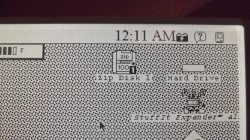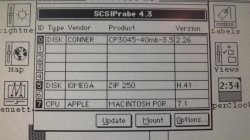I did a small amount of surfing around the forums looking for info beforehand but didn't find much.
I'm wondering if anyone has ever used a zip drive on a Macintosh Portable, and if so, they'd be willing to help me get a zip drive working with mine.
I came across a z250s at a Goodwill and figured 10 bucks was worth giving it a shot.
I bought some 250MB zip disks from Amazon (probably should have went with 100mb disks) and a 25 pin male/male cable that fits both the drive and the portable; whether it's a scsi cable or not, I've no clue.
I got the Iomega Zip Tools from Macintosh Gardens; it says it works for system 7 and my portable has 7.1.
After following the instructions for hooking it up (power off everything, hook up zip drive, power everything back on, etc.), making sure it was terminated and then starting everything up, the 'Zip Install' software didn't detect any scsi drives and neither did scsi probe.
After spending quite some time troubleshooting booting with extensions disabled, different scsi ID's (5 or 6), resetting PRAM (I think that's what it was called), etc., I figured that maybe 250mb drives didn't work with system 7, the 250mb disks weren't compatible with system 7 or maybe the cable wasn't actually a scsi cable. I do have two zip 100 m/f scsi cables, but both the ports on the z250s drive and Mac Portable are female, so I need a M/M cable.
Before spending more money on a zip 100 drive/100mb disks, I'd like to know that it's definitely possible to get them to work with a portable with system 7, or if maybe I'm doing something wrong with the 250mb drive/disks/cable.
I can easily provide pics if necessary, and any help would/will be appreciated.
I'm wondering if anyone has ever used a zip drive on a Macintosh Portable, and if so, they'd be willing to help me get a zip drive working with mine.
I came across a z250s at a Goodwill and figured 10 bucks was worth giving it a shot.
I bought some 250MB zip disks from Amazon (probably should have went with 100mb disks) and a 25 pin male/male cable that fits both the drive and the portable; whether it's a scsi cable or not, I've no clue.
I got the Iomega Zip Tools from Macintosh Gardens; it says it works for system 7 and my portable has 7.1.
After following the instructions for hooking it up (power off everything, hook up zip drive, power everything back on, etc.), making sure it was terminated and then starting everything up, the 'Zip Install' software didn't detect any scsi drives and neither did scsi probe.
After spending quite some time troubleshooting booting with extensions disabled, different scsi ID's (5 or 6), resetting PRAM (I think that's what it was called), etc., I figured that maybe 250mb drives didn't work with system 7, the 250mb disks weren't compatible with system 7 or maybe the cable wasn't actually a scsi cable. I do have two zip 100 m/f scsi cables, but both the ports on the z250s drive and Mac Portable are female, so I need a M/M cable.
Before spending more money on a zip 100 drive/100mb disks, I'd like to know that it's definitely possible to get them to work with a portable with system 7, or if maybe I'm doing something wrong with the 250mb drive/disks/cable.
I can easily provide pics if necessary, and any help would/will be appreciated.




